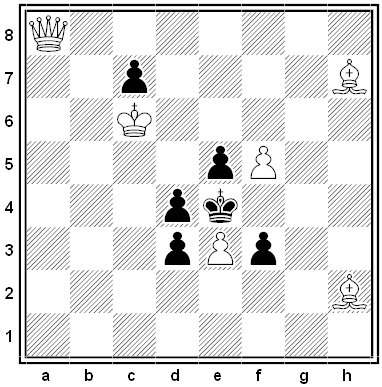Puzzles
Tank Hunt
A puzzle from Daniel J. Velleman and Stan Wagon’s excellent 2020 problem collection Bicycle or Unicycle?:
Before you is a field of 225 squares arranged in a 15×15 grid. One of the squares contains a perfectly camouflaged tank that you’re trying to destroy. You have a weapon that will destroy one square of the grid with each shot, but it takes two shots to destroy the tank, and you know that when the tank has been hit the first time (and only then) it will flee invisibly to an adjacent square (horizontally or vertically). What’s the minimum number of shots you’ll need to be sure of destroying it?
The Wine-Bin

A puzzle by Claude Gaspar Bachet de Méziriac, from 1612, via Henry Dudeney:
A gentleman had a wine-bin of eight compartments, as in the illustration, containing 60 bottles, arranged as shown. His dishonest servant stole 4 bottles and rearranged the remainder. The gentleman noticed that the bottles had been redistributed, but as there were still 21 bottles on every side he innocently concluded that all the 60 were there. The servant, emboldened by his success, again stole 4 bottles and rearranged the remainder without discovery. In fact, on two more occasions he repeated his theft of 4 bottles, always leaving the remainder so arranged symmetrically that there were 21 on every side. How did he arrange them on the four occasions so as to steal the 16 bottles?
Implementia

A puzzle by Yoshinao Katagiri: A boy and a girl played rock paper scissors 10 times. Altogether the boy played rock three times, scissors six times, and paper once, and the girl played rock twice, scissors four times, and paper four times (though, in each case, the order of these plays is unknown). There were no ties. Who won?
Fixing a Point
A problem proposed by Richard Hoshino and Sarah McCurdy for Crux Mathematicorum, September 2008:
Five points lie on a line. Here are the 10 distances between pairs of points, listed from smallest to largest:
2, 4, 5, 7, 8, k, 13, 15, 17, 19
What’s k?
Black and White
Enlightenment
You’re in a dark room. The only light comes from an old LED digital alarm clock with four seven-segment displays. The time is displayed in 24-hour format, HH:MM (no seconds), and the leading digit is blank if not used. How much time passes between the room’s darkest state and its lightest?
Black and White
Harmony
A problem from the January 1990 issue of Quantum: Forty-one rooks are placed on a 10 × 10 chessboard. Prove that some five of them don’t attack one another. (Two rooks attack one another if they occupy the same row or column.)
Quickie
One other quick item from Eureka, the journal of the Cambridge University Mathematical Society:
In its 1947 problem drive, the society proposed the following problem:
To find unequal positive integers x, y, z such that
x3 + y3 = z4.
“Although there were some research students in Theory of Numbers among those who tried, not one person succeeded in solving it within the time, yet the solution is extremely simple.” What is it?




